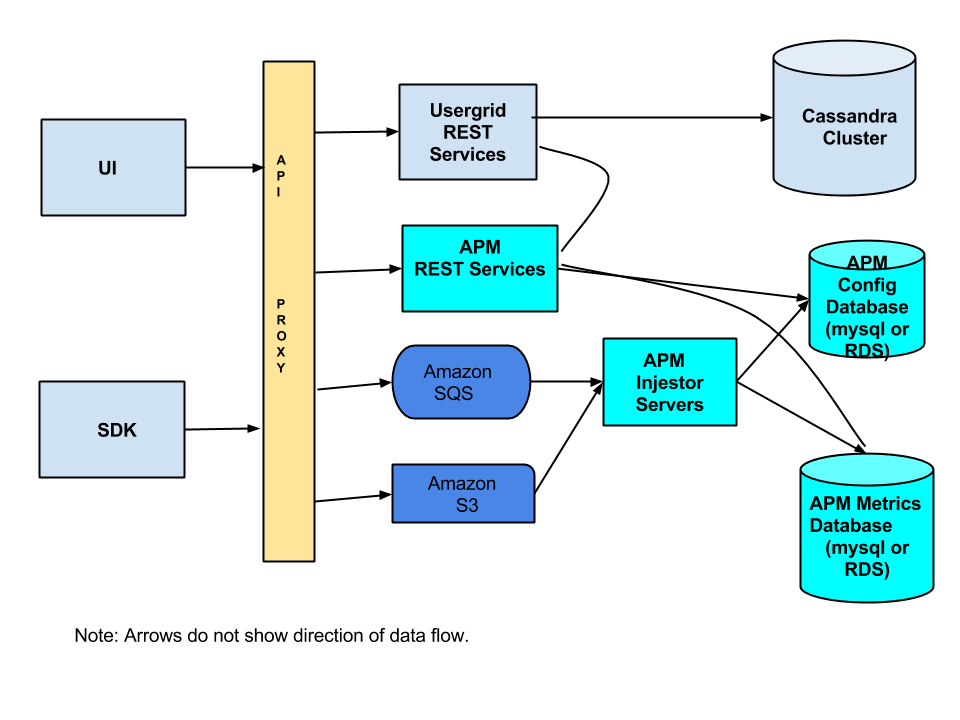For Developers Getting Started with Usergrid App Performance Monitoring (APM) also known as Usergrid Mobile Analytics.
Pre-requisites:
- Able to build Usergrid from source.
- AWS account with access to SQS and S3
- MySql or Amazon RDS
Database Setup:
- Install MySQL 5.5/5.6 locally or use Amazon RDS.
- Create a new user with all DB permissions and note password.
- Create two databases named instaops_appmanagement and instaops_analytics.
- Into instaops_appmanagement, import schema from db-schemas/apm-config-schema.sql. Verify that tables got created.
- Into instaops_analytics, import schema from db-schemas/apm-metrics-schema.sql Verify that tables got created.
- Make sure that user you created has full access to these two schemas.
Building the application
- To do a quick build:
mvn clean install -DskipTests - To do a build with tests
mvn clean install
Build produces two wars. One for injestor named usergrid-apm-injestor and one for REST services named usergrid-apm-rest.
usergrid-apm-rest.war is a superset of usergrid-apm-injestor.war so for local testing, you only need to deploy REST .war file and it will
work as injestor too as long as properties file (see below) is set correctly. In production, recommendation is to have separate server instances
for injestor and REST servers.
Properties file
All together 3 props file need to be in classpath. To ease with .war deployments across different planets and avoid confusion with Ops, we recommended that Ops copies these props file to lib folder of tomcat. It's recommended to do the same while testing locally or you can put these files in service/src/main/resources. You can see example of these files under portal-service/src/test/resources
hibernate-analytics.cfg.xml : make sure to update DB connection, username and password properties
hibernate-app-management.cfg.xml : make sure to update DB connection, username and password properties)
deployment-config.properties : make sure to update AWS keys, SQS account number, S3 bucket, enable/disable injestor
Deploy
- Verify that 3 properties files are present in tomcat's lib folder.
-Rename the .war from
rest/target/usergrid-apm-rest.warto ROOT.war and deploy it to Tomcat with Injestor enabled indeployment-config.propertiesfile. You should not see any error in catalina.out
Verify the application is running at : -http://localhost:8080/apm/status (app context will change if you use different maven profile and your version is different) -If you have Demo Org and Demo App created using DemoAppDataPopulator (you can run it in your IDE or from command line), then you should be able to get metrics for example at: http://localhost:8080/Demo/AcmeBank/apm/networkRawData/1
This takes care of App Monitoring deployment
** Complete end to end deployment**
- System diagram
-Have a running Usergrid configured with APM. When a new app gets created, Usergrid makes a REST call to APM to register a new app. During crash log parsing, APM makes a REST call to Usergrid to find who to send email notification too. [More details to be added]
This README doc needs to have more details and will be updated.
FAQ*
- Why is this code not merged with Apache Usergrid code ?
Glad you asked. APM depends on few libraries such as Hibernate which are LGPL and Apache strictly prohibits a project or subproject from having a dependency on LGPL code base. While it's not a humungous effort to move to OpenJPA from Hibernate, it's not a trivial work. We slowly hope to get there.
